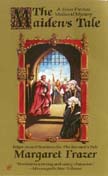A
MEDIEVAL YEAR IN ENGLAND:
NOVEMBER This is a gray and
glooming month, known for its rain and wind and fog, with hardly nine
and a half hours of light to the day at the month’s beginning, and less
before it ends. To the Saxons it was Wint monath – the Wind month – or else Bot monath, the bloody month for slaughtering the winter meat. Nov.
1 is the Feast of All Saints, called All Hallows Day. Grown out of
pagan celebrations to honor the dead as the year enters its own death,
it is one of the four great feasts of the Church year (the others
coming in February, May and August – Candlemas, Whitsuntide, and
Lammas) All Hallows Eve, the night before All Hallows, may be riotous
but the day itself is solemnly religious. Nov. 2 is the Feast of
All Souls, celebrating the memory of all who have died, particularly
those in Purgatory. Poor folk go a-souling for the day, singing carols
from door to door and begging for Soul Cakes. During the day church
bells toll and services are held, and in some places lighted candles
are placed in windows to comfort the dead. Nov. 11 is St.
Martin’s day, called Martinmas. An unseasonable spell of warm weather
around now is known as St. Martin’s summer. The winter planting
if it runs this late ends now, and if the frosts are not too deep in
the ground yet there may be some plowing of fields in preparation for
early spring planting. But the month’s main work now is the
slaughtering of all the animals that cannot be kept over the winter,
including pigs fattened in the woods last month. With the slaughtering
comes the salting down of the meat, and the tanning of hides for
leather, and soap- and glue-making, and whatever else can be had from
the carcasses. Now is also the time for repairing buildings
against winter weather; for cleaning chimneys to prevent fires; for
clearing privies and taking their refuse to bury in trenches in gardens
for fertilizing. Threshing – prepared for at harvest’s end – begins
now, though only grain that is immediately needed is threshed since
unthreshed grain is thought to keep better. Smiths will be sharpening
horses’ shoes and fixing the spurn bar across them to prevent the
horses’ slipping on the ice to come. But it is said that
If there is ice in November that will bear a duck
There’ll be nothing after but sludge and muck.
For hunters, roedeer and hare are still in season (since September) and bird-netting continues (to Candlemas). On
Nov. 30 is St. Andrew’s day. The dairy work of milk, cream, butter,
and cheese-making that has gone on from April ends now so that the cows
can be freshened for Spring calving and next year’s milk. About
now, on the Sunday closest to St. Andrew’s day, Advent begins, turning
attention from the year end’s work toward the great midwinter holidays
of December. 
November 1439 - Margaret |